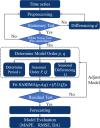Spatiotemporal analysis and forecasting of public attention to China's five major religions
- PMID: 40781357
- PMCID: PMC12334767
- DOI: 10.1038/s41598-025-15396-9
Spatiotemporal analysis and forecasting of public attention to China's five major religions
Abstract
In the digital era, leveraging search engine data to gain insights into public interests and attitudes towards religion has become increasingly important. To examine the spatiotemporal evolution and develop a forecasting model of public attention to China's five major religions (Buddhism, Taoism, Catholicism, Christianity and Islam), this study introduces geographic information system technology, forecasting technology and spatiotemporal analysis methods into religious research, using Baidu Index data from 2020 to 2024. The results show that most religions exhibit stable annual public attention, although significant changes occur during specific seasons, festivals or events. Spatial variation in public attention is moderate, with a relatively balanced regional distribution. However, a distinct east-west clustering pattern is evident, reflecting spatial aggregation. The SARIMA-based forecasting model effectively captures temporal dynamics and demonstrates strong forecasting performance. Findings reveal the spatiotemporal distribution patterns of religious public attention and highlight the practical value of the forecasting model, thereby emphasising the importance of considering spatial factors and forecasting models when addressing the dissemination of religion in the digital age. This study provides new methods and perspectives for religious research, promoting an interdisciplinary synthesis of religious studies, sociology and geography. It offers new insights into global religious studies, religious communication strategies and cultural exchange. Furthermore, it contributes to advancing cross-cultural and cross-regional religious research and offers valuable references for religious organisations and policymakers in managing religious affairs, adjusting policies and optimising communication strategies in a globalised context.
Keywords: Forecasting; GIS technology; Public attention; Religion; Spatiotemporal analysis.
© 2025. The Author(s).
Conflict of interest statement
Declarations. Competing interests: The authors declare no competing interests.
Figures






Similar articles
-
Short-Term Memory Impairment.2024 Jun 8. In: StatPearls [Internet]. Treasure Island (FL): StatPearls Publishing; 2025 Jan–. 2024 Jun 8. In: StatPearls [Internet]. Treasure Island (FL): StatPearls Publishing; 2025 Jan–. PMID: 31424720 Free Books & Documents.
-
Accreditation through the eyes of nurse managers: an infinite staircase or a phenomenon that evaporates like water.J Health Organ Manag. 2025 Jun 30. doi: 10.1108/JHOM-01-2025-0029. Online ahead of print. J Health Organ Manag. 2025. PMID: 40574247
-
Sexual Harassment and Prevention Training.2024 Mar 29. In: StatPearls [Internet]. Treasure Island (FL): StatPearls Publishing; 2025 Jan–. 2024 Mar 29. In: StatPearls [Internet]. Treasure Island (FL): StatPearls Publishing; 2025 Jan–. PMID: 36508513 Free Books & Documents.
-
A systematic review of religious beliefs about major end-of-life issues in the five major world religions.Palliat Support Care. 2017 Oct;15(5):609-622. doi: 10.1017/S1478951516001061. Palliat Support Care. 2017. PMID: 28901283 Free PMC article.
-
The Lived Experience of Autistic Adults in Employment: A Systematic Search and Synthesis.Autism Adulthood. 2024 Dec 2;6(4):495-509. doi: 10.1089/aut.2022.0114. eCollection 2024 Dec. Autism Adulthood. 2024. PMID: 40018061 Review.
References
-
- Simon, K. Digital 2025: Global Overview Report [Online]. (2025). Available: https://datareportal.com/reports/digital-2025-global-overview-report
-
- Brin, S. & Page, L. Reprint of: the anatomy of a large-scale hypertextual web search engine. Comput. Networks. 56, 3825–3833 (2012).
-
- Vila, T. D., González, E. A., Vila, N. A. & Brea, J. A. F. Indicators of website features in the user experience of e-tourism search and metasearch engines. J. Theor. Appl. Electron. Commer. Res.16, 18–36 (2021).
-
- Chen, J. et al. When large Language models Meet personalization: perspectives of challenges and opportunities. World Wide Web. 27, 42 (2024).
-
- Kim-Prieto, C. & Diener, E. Religion as a source of variation in the experience of positive and negative emotions. J. Posit. Psychol.4, 447–460 (2009).
Grants and funding
LinkOut - more resources
Full Text Sources

